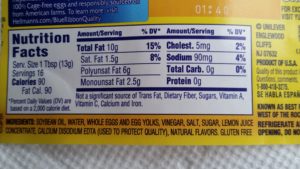 I've been reading and thinking about "natural flavors" ever since my earlier posts about food additives (April 20, 2015, August 19, 2014). What exactly are natural flavors and how are they different from artificial flavors? And why are they even found in organic foods? The more I read, the more I want to avoid them , but it seems to be really, really hard to do so because they seem to be everywhere, even in what we think of as basic foods (e.g., butter). Bottom line: both are chemicals concocted in labs and manufactured in factories. Read labels and try to eat as many unprocessed foods as possible to avoid them.We know very little about many of them, and if they have health effects. Note that the term "natural flavors" may include many chemicals in the "flavor mixtures" (incidental additives) that don't have to be listed on the labels. Currently there are more than 2700 natural flavors being used in the USA. The following are excerpts from articles and a book published in 2015.
I've been reading and thinking about "natural flavors" ever since my earlier posts about food additives (April 20, 2015, August 19, 2014). What exactly are natural flavors and how are they different from artificial flavors? And why are they even found in organic foods? The more I read, the more I want to avoid them , but it seems to be really, really hard to do so because they seem to be everywhere, even in what we think of as basic foods (e.g., butter). Bottom line: both are chemicals concocted in labs and manufactured in factories. Read labels and try to eat as many unprocessed foods as possible to avoid them.We know very little about many of them, and if they have health effects. Note that the term "natural flavors" may include many chemicals in the "flavor mixtures" (incidental additives) that don't have to be listed on the labels. Currently there are more than 2700 natural flavors being used in the USA. The following are excerpts from articles and a book published in 2015.
From CNN: What are natural flavors, really?
Look at the food label of almost any packaged good you consume and odds are you'll spot the term "natural flavors." But have you ever wondered what this mysterious additive actually contains? The answer isn't as clear as you might think.Though natural flavors may sound better than their presumably chemical-laden alternative — artificial flavors — it turns out they are not actually all that different.
In the Environmental Working Group's Food Scores database of over 80,000 foods, "natural flavor" is the fourth most common ingredient listed on labels. The only ingredients that outrank it: salt, water and sugar. Yet, natural flavoring isn't nearly as simple as these three pantry staples."Natural and artificial flavors play an interesting role in food. They're essentially providing the taste and often they're added to make the food more appealing, or to potentially replace something that's lost through processing, storage or in some cases even from pasteurizing," says David Andrews, senior scientist at the Environmental Working Group. One place you'll often spot natural or artificial flavor is in orange juice; manufacturers will add faux flavor to juice after it's packaged in the plant, to ensure uniformity.
"The differentiation is really down to the origin of those molecules, whether synthetically processed in a lab or purified in a lab but from a natural source," Andrews says. Here's where it gets even muddier: Added flavoring, both natural and artificial, could contain anywhere from 50 to 100 ingredients. And all of the extra ingredients in flavors often aren't as innocent as you'd hope they would be."The mixture will often have some solvent and preservatives — and that makes up 80 to 90 percent of the volume [of the flavoring]. In the end product, it's a small amount, but it still has artificial ingredients," Andrews says. ...continue reading "What’s In the “Natural” Flavors In Our Foods?"
